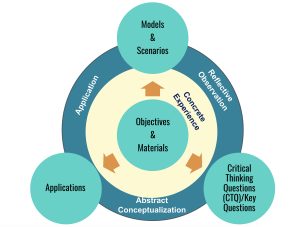Instructors: OER Design with Guided Inquiry Learning Approach
Elizabeth A. Johnson; Juhong Christie Liu; and Mark Peale
OER Design with Guided Inquiry Learning Approach
There are two crucial aspects to the design of a Guided Inquiry Learning activity. First, a model or guiding worksheet with well-selected sufficient information, clearly-stated objectives, and meaningful prompts must be provided for students to “experience” or “explore” so that they can lay the foundation for students to understand desired concepts, theories, or principles. Second, the guiding questions are sequenced in a carefully constructed manner so that not only do students reach the appropriate conclusion but at the same time students will be able to develop and implement various process and learning skills. The third aspect, usually optional and voluntary but essential to laboratory-based science learning, is group work and/or potential application scenarios. The small groups can be formulated with self-selection or facilitated by the instructor.
Typically the guided inquiry activity starts with a brief description of the unit and learning objectives. The expectation of prior knowledge is also stated along with the objectives so that student initial engagement with learning content can be established. The core of this type of inquiry-based learning consists of guiding questions. These questions direct student attention to the information presented with the model, scaffold student recognition of the relationships and patterns in the data, and lead toward their concept development. Based on these, students will be able to reflect the possible application of the learned knowledge, and when necessary collaborate with group members to dig deeper into the learning process. An inquiry-based learning activity usually concludes with questions that may involve applying the concepts to new situations and generalizing students’ new knowledge and understanding. Thus, Guided Inquiry Learning activities follow the structure of the learning cycle, concept invention, and application, and improve long-term retention of scientific knowledge (Vanags, Pammer, & Brinker, 2013).
Process-oriented Guided Inquiry Learning (POGIL) is an active learning strategy that initially appeared in teaching chemistry courses (Farrell, Moog, & Spencer, 1999) and was later adopted widely in teaching and learning of science. It has the roots in a Piagetian model of learning and has integrated the principles and concepts of inquiry-based learning and experiential learning cycles in science and laboratory education (Abdulwahed & Nagy, 2009; Kolb, 2014; Piaget, 1964). POGIL has been proved effective in science learning (Freeman, Eddy, McDonough, Smith, Okoroafor, Jordt, & Wenderoth, 2014; Vanags, Pammer, & Brinker, 2013).
Image source: https://serc.carleton.edu/sp/pkal/pogil/what.html
The core components of a POGIL lesson includes Scenarios and Models, Critical Thinking Questions (CTQ) or Key Questions, and Applications. Scenarios provide a description of the learning unit, objectives, and prerequisite knowledge. Models are the presentation of the subject content of the unit in multiple formats to ensure learners with all abilities to have access. Key Questions are designed to engage students with the effective engagement of the learning. Applications are intended for students to be able to associate the learned knowledge with future learning and/or real-world practices. In a laboratory-based learning environment, these components provide scaffolding for students to perform reflective observation, be able to reach abstract conceptualization, and apply the conceptual knowledge to actual operation, analysis, and synthesis. These happen with concrete experiences, align with learning objectives, and are supported with learning materials.

A POGIL Scenario sets the context and main theme for a learning activity. The setting objectives and starting a unit with core questions are very similar to the Gaining Attention step in Gagne’s Conditions of Learning.
This Guide provides suggestions for learning activities and assessment, for instructors.
Resources
- Abdulwahed, M., & Nagy, Z. K. (2009). Applying Kolb’s experiential learning cycle for laboratory education. Journal of engineering education, 98(3), 283-294.
- Moog, R. S., Spencer, J. N., & Straumanis, A. R. (2006). Process-oriented guided inquiry learning: POGIL and the POGIL project. Metropolitan Universities, 17(4), 41-52.
- Freeman, S., Eddy, S. L., McDonough, M., Smith, M. K., Okoroafor, N., Jordt, H., & Wenderoth, M. P. (2014). Active learning increases student performance in science, engineering, and mathematics. Proceedings of the National Academy of Sciences, 111(23), 8410-8415. https://www.pnas.org/content/111/23/8410
- Kolb, D. A. (2014). Experiential learning: Experience as the source of learning and development. FT press. [Link will open in a new tab.]
- Pedaste, M., Mäeots, M., Siiman, L. A., De Jong, T., Van Riesen, S. A., Kamp, E. T., … & Tsourlidaki, E. (2015). Phases of inquiry-based learning: Definitions and the inquiry cycle. Educational Research Review, 14, 47-61.
- Vanags, T., Pammer, K., & Brinker, J. (2013). Process-oriented guided-inquiry learning improves long-term retention of information. Advances in Physiology Education, 37(3), 233-241. doi:10.1152/advan.00104.2012.
- Wikipedia (ret. 7/9/2019) POGIL. https://en.wikipedia.org/wiki/POGIL
- https://serc.carleton.edu/sp/pkal/pogil/what.html
- https://serc.carleton.edu/sp/pkal/pogil/why.html
- https://serc.carleton.edu/sp/pkal/pogil/references.html
Introduction to Petrology by Elizabeth Johnson, Juhong Christie Liu, and Mark Peale is licensed under a Creative Commons Attribution 4.0 International License, except where otherwise noted.
This chapter contains material from “POGIL” by Wikipedia which is licensed under CC BY-SA 4.0.
Media Attributions
- scenario-Models-POGIL-Johnson-Liu


